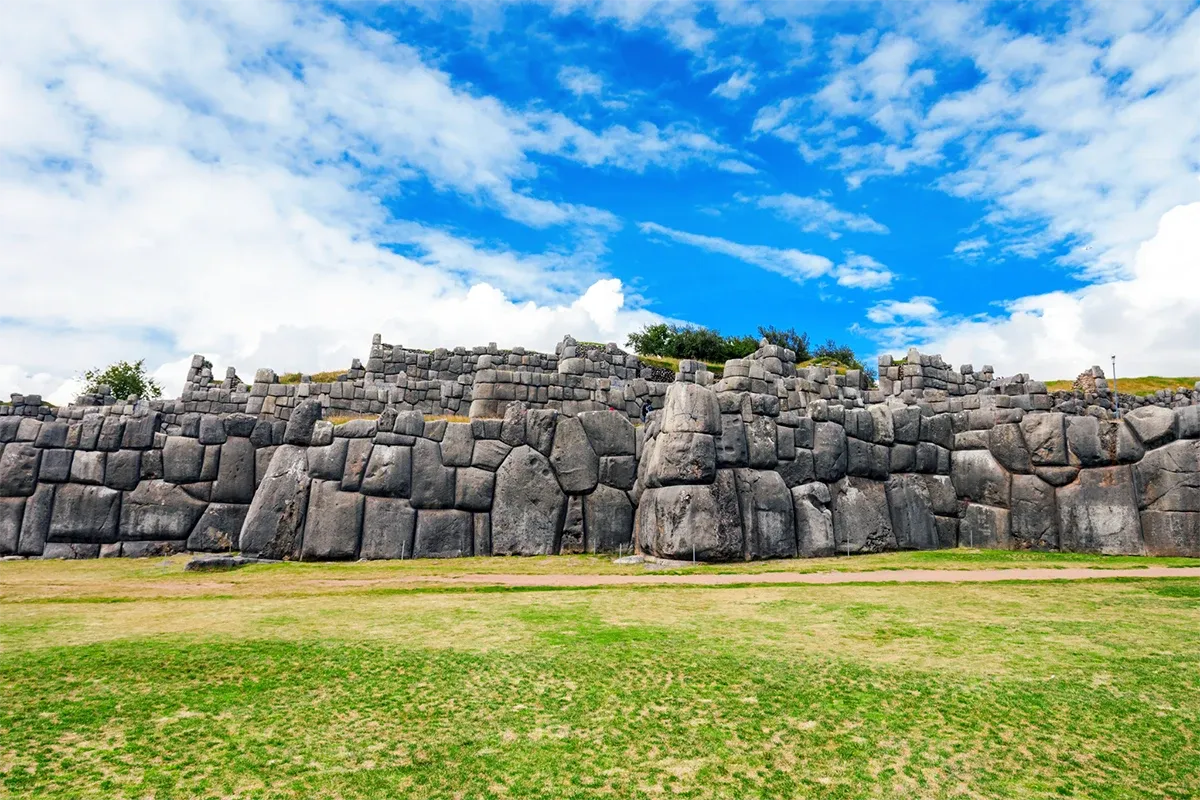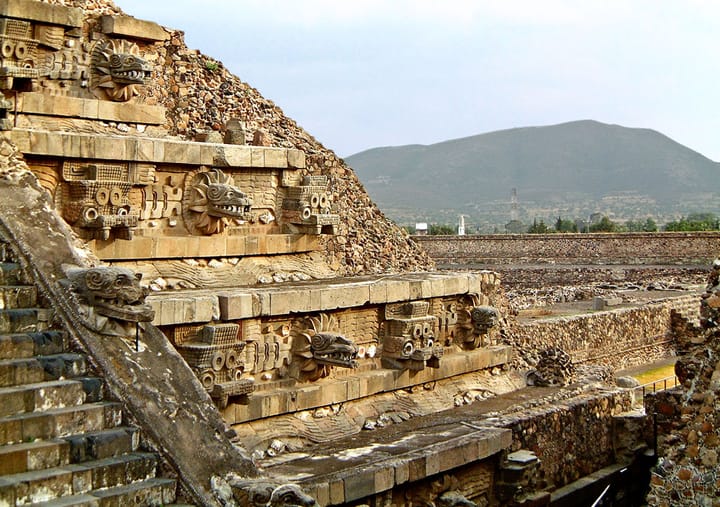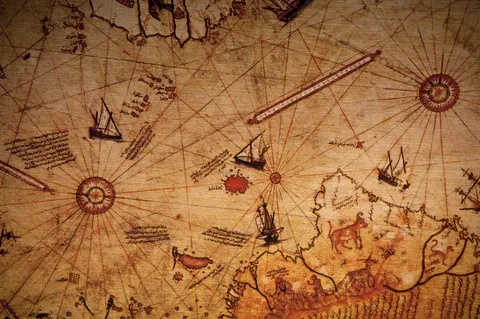Sacsayhuamán
On the ridge above historic Cusco, Sacsayhuamán’s zigzag terraces and tight-fit polygonal masonry show Inca engineering at scale.

Quick Take
- Massive zigzag walls crown the ridge north of Cusco with precision polygonal blocks. Wikipedia
- Principal construction dates to the 1400s during the imperial expansion from Cusco. Wikipedia
- Dry-stone (no mortar) masonry with drafted margins and keyed joints. svtsm.ch
- Ritual–defense hybrid role for the acropolis above the capital. UNESCO World Heritage Centre
- Managed today as the Parque Arqueológico Nacional de Saqsaywaman by Peru’s Ministry of Culture. culturacusco.gob.pe+1
Quick Facts
- Type: Hilltop complex with three great zigzag terraces, plazas, towers, gates, causeways, reservoirs. Wikipedia
- Location: Cusco, Peru (~3,700 m). Wikipedia
- Period: Primarily 15th century; part of the UNESCO-listed “City of Cuzco.” UNESCO World Heritage Centre
- Materials: Predominantly limestone mega-blocks with fine-fit polygonal joints; selected andesite features. Wikipedia
- Notable features: Serpentine curtain walls; tight joints without mortar; inward batter and setbacks supporting seismic stability. svtsm.ch+1
Why This Matters
Sacsayhuamán is a masterclass in highland logistics and seismic design. It demonstrates how the Inca state mobilized labor, stone, water, and ceremony to shape a capital’s skyline...its engineering strategies (batter, keyed joints, polygonal blocks) are still studied for earthquake performance. Semantic Scholar
Timeline
- Pre-Inca occupation: Hill used before the imperial build (context within the broader UNESCO “City of Cuzco”). UNESCO World Heritage Centre
- 15th century: Major Inca construction under Pachacuti and successors. Wikipedia
- 1536: Siege of Cusco; Sacsayhuamán becomes a key battlefield (site histories summarized on UNESCO/WHS). UNESCO World Heritage Centre
- Colonial era: Reuse of blocks for churches and civic buildings in Cusco (standard site histories). Wikipedia
- Present: Managed by Peru’s Ministry of Culture (Cusco DDC); Master Plan updated to 2030. gob.pe+1
Claims and Evidence
Claim 1: Stones were fitted without mortar using staged lifts and hand tools.
Evidence: Classic field work by Jean-Pierre Protzen documents quarrying, transport, drafted margins, and tight-fit faces achieved with hammering/pecking and staged setting. svtsm.ch
Assessment: Strong.
Claim 2: Quarry and haul were local and labor-intensive; Inca logistics could also move stones long distances when ordered.
Evidence: Local quarries and haul roads around Cusco are standard in site syntheses; empire-wide capacity for long-haul stone is demonstrated by Ogburn’s study of blocks moved from Cuzco toward Saraguro (Ecuador). Wikipedia+1
Assessment: Strong for local sourcing; long-distance capability evidenced elsewhere in the Inca realm.
Claim 3: The layout served both ritual and defense at the city’s head.
Evidence: UNESCO “City of Cuzco” inscription frames the ceremonial-political heart; Sacsayhuamán’s elevated terraces, towers, and gates are treated as a fortress-temple complex in standard references. UNESCO World Heritage Centre+1
Assessment: Supported hybrid role.
Claim 4: Seismic stability was intentional.
Evidence: Archaeoseismology and structural papers describe the earthquake-resistant performance of polygonal Inca masonry—batter, interlocking faces, and energy dissipation. Semantic Scholar
Assessment: Strong principle; modeling continues (see 2024 numerical analysis focused on Sacsayhuamán wall behavior). ResearchGate
Claim 5: The site is legally protected and actively managed under a current Master Plan.
Evidence: Ministry of Culture announcement (2024) approving the 2024–2030 plan; DDC Cusco’s official Saqsaywaman portal. gob.pe+1
Assessment: Strong.
Network and Influence
- Connected centers: Qorikancha (Cusco), Qenqo, Tambomachay, Pukapukara—administered within the Saqsaywaman Archaeological Park network. culturacusco.gob.pe
- State system: Part of the imperial road/labor/storehouse system that enabled quarrying and rapid monumentalization; parallel logistics evidenced by Ogburn (2004). JSTOR
- Living culture: Inti Raymi and public events on the terraces (DDC Cusco communications). Facebook
Key Documents and Media
- UNESCO World Heritage: City of Cuzco (includes Sacsayhuamán). UNESCO World Heritage Centre
- DDC Cusco: Saqsaywaman official portal (site jurisdiction, components, protection). culturacusco.gob.pe
- Master Plan (2024–2030): Saqsayhuamán (regulatory & management framework). transparencia.cultura.gob.pe+1
- Protzen (1983): Inca Quarrying and Stonecutting (methods, drafted margins, handling). svtsm.ch
- Hinzen (2017): archaeoseismology of polygonal vs. rectangular masonry. Semantic Scholar
- Lipa et al. (2024): numerical seismic analysis of a Sacsayhuamán wall. ResearchGate
Controversies
- Tooling precision: Protzen shows pecking/dressing can achieve the tight fits...ongoing debate mostly about sequences, not about “mysterious” tech. svtsm.ch
- Block weights: Orders of magnitude are clear even when exact tonnages vary across popular accounts; primary focus remains on fit and stability. Wikipedia
- Primary function: Fortress vs. state temple vs. dual-use acropolis...most syntheses accept a hybrid role above the capital. UNESCO World Heritage Centre
Open Questions
- Exact sequence of quarry benches and lift stages for the largest stones (Protzen outlines candidates; end-to-end reconstructions remain rare). svtsm.ch
- How terrace drainage and reservoirs integrated with storm performance (park documents discuss hydrology management). transparencia.cultura.gob.pe
- Superstructure form of the lost towers and how they read from the city below (site histories acknowledge loss). Wikipedia
- Labor calendar and crew organization pacing quarry, haul, and fit...comparative logistics in the Inca realm point to capacity. JSTOR
- Fine-scale seismic response of different wall segments under varying PGA (recent modeling is a start). ResearchGate
Suggested Clips and Pull Quotes
- Slow glide along a zigzag seam where three giant stones meet (show drafted margin & tight joint). svtsm.ch
- Close shot of a polygonal joint with a leaf-test moment.
- Pull quote: “Stone that behaves like fabric.”
- Pull quote: “A skyline built for ceremony and siege.”
How We Are Covering This
We synthesize UNESCO and Peru’s official park documentation for baselines, then lean on fieldwork (Protzen) and structural/archaeoseismology research (Hinzen; Lipa et al.) for methods and performance. Where public lore drifts, we re-anchor to primary/official sources. Semantic Scholar+3UNESCO World Heritage Centre+3transparencia.cultura.gob.pe+3
Current Assessment
High-altitude monumentality with elite craft and robust seismic logic. The complex is both a ritual stage for Cusco and a defensive crown. Many upper works are gone, but the core walls still teach. UNESCO World Heritage Centre
What If
Speculative entertainment lens for your audience.
What if the zigzags are sky echoes
The plan mirrors lightning paths and Milky Way bends to place the city in a cosmic frame.
So what: parades walked a star map on the ground.
What if the giant blocks are social contracts in stone
Each mega-fit marks a feast or alliance.
So what: the wall is a ledger you can touch.
What if the walls were tuned
Angles, pockets, and niches foster sound focus for chant and signal.
So what: ceremony and command share the same acoustics.
What if hidden binders are a code
Back-keyed stones form repeating ratios along the terrace.
So what: metrology and message ride together.
Signals to watch
- Repeating angle sets across terrace breaks
- Consistent drafted-margin widths as a unit of measure
- Acoustic hotspots at gates and tower bases
- Quarry-to-wall block families that reveal crew signatures
Kicker
If the hill is a protocol, the question is not only how the joints fit. It is how the city learned to move to their rhythm.
Credits and Further Reading
- UNESCO World Heritage Centre – City of Cuzco (inscription including Sacsayhuamán). UNESCO World Heritage Centre
- DDC Cusco – Saqsaywaman official portal (site overview, legal status). culturacusco.gob.pe
- Master Plan 2024–2030 – Saqsayhuamán (Ministerio de Cultura Peru) (management & protection framework). transparencia.cultura.gob.pe
- Protzen, J-P. (1983) Inca Quarrying and Stonecutting (methods & fits). svtsm.ch
- Hinzen, K. (2017) Rectangular blocks vs. polygonal walls in archaeoseismology (earthquake behavior). Semantic Scholar
- Lipa, C. et al. (2024) Seismic numerical analysis of an Inca stone wall in Sacsayhuamán (finite-element modeling). ResearchGate
- Ogburn, D. (2004) Evidence for Long-Distance Transportation of Building Stones in the Inka Empire (logistics capacity). JSTOR



Comments ()